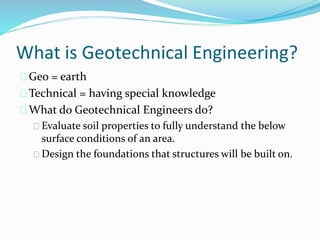Geotheta Fundamentals Explained
Table of ContentsGeotheta - Questions10 Simple Techniques For GeothetaGeotheta Things To Know Before You Get ThisThe Geotheta StatementsIndicators on Geotheta You Need To Know

They perform site investigations, accumulate samples, carry out laboratory tests, and examine data to review the viability of the ground for construction tasks - Geotechnical Engineers. Based upon their findings, geotechnical designers offer referrals for structure layout, incline stability, preserving frameworks, and reduction of geotechnical hazards. They collaborate with various other experts, such as engineers, architectural designers, and construction groups, to guarantee that geotechnical considerations are integrated right into the general job layout and implementation
By examining the behavior and residential properties of dirt and rock, they can recognize possible geotechnical hazards such as landslides, soil negotiation, or incline instability. Their expertise assists prevent failings or crashes that might endanger lives and residential or commercial property. Here are some in-depth tasks and responsibilities of a geotechnical engineer: Website Investigation: Geotechnical designers conduct site investigations to collect information on subsurface problems.
They analyze the data to understand the homes and actions of the dirt and rock, including their strength, leaks in the structure, compaction features, and groundwater conditions. Geotechnical Evaluation and Layout: Geotechnical engineers assess the information collected during website investigations to assess the stability and suitability of the site for building and construction projects. They carry out geotechnical computations and modeling to assess factors such as birthing capability, settlement, slope stability, lateral planet pressures, and groundwater flow.
4 Easy Facts About Geotheta Described
Structure Layout: Geotechnical engineers play an important role in creating structures that can safely support the desired framework. They evaluate the dirt conditions and lots needs to determine the appropriate structure type, such as shallow structures (e.g., grounds), deep structures (e.g (https://pubhtml5.com/homepage/jugmn/)., stacks), or specialized methods like dirt renovation. They think about elements such as negotiation limits, bearing capacity, and soil-structure interaction to develop optimum structure styles
They evaluate construction plans, display site activities, and perform area assessments to confirm that the design recommendations are adhered to. If unanticipated geotechnical problems arise, they assess the scenario and supply recommendations for removal or modifications to the design. Threat Evaluation and Reduction: Geotechnical engineers assess geotechnical threats and dangers connected with the task site, such as landslides, liquefaction, or dirt disintegration.

Collaboration and Interaction: Geotechnical designers work closely with various other experts involved in a project, such as engineers, structural designers, and building and construction teams. Reliable interaction and collaboration are vital to integrate geotechnical factors to consider into the total job layout and building process. Geotechnical designers offer technological experience, response questions, and guarantee that geotechnical requirements are fulfilled.
How Geotheta can Save You Time, Stress, and Money.
Here are some kinds of geotechnical designers: Foundation Engineer: Foundation designers specialize in developing and assessing foundations for structures. They evaluate the dirt problems, lots requirements, and site qualities to figure out the most proper structure kind and design, such as shallow foundations, deep foundations, or specialized methods like heap foundations.
They examine the aspects affecting incline security, such as soil properties, groundwater conditions, and slope geometry, and establish techniques to stop slope failures and mitigate threats. Earthquake Engineer: Earthquake engineers focus on examining and creating frameworks to stand up to seismic pressures. They analyze the seismic hazard of a website, review dirt liquefaction capacity, and establish seismic style standards to make sure the safety and security and strength of frameworks throughout earthquakes.
They carry out field screening, accumulate examples, and examine the gathered data to characterize the dirt residential properties, geologic formations, and groundwater conditions at a site. Geotechnical Instrumentation Designer: Geotechnical instrumentation engineers focus on monitoring and measuring the actions of dirt, rock, and frameworks. They install and maintain instrumentation systems that check aspects such as soil settlement, groundwater degrees, slope activities, and structural displacements to analyze performance and provide very early warnings of possible problems.
Little Known Facts About Geotheta.
They conduct tests such as triaxial examinations, consolidation tests, straight shear tests, and leaks in the structure tests to gather information for geotechnical evaluation and design. Geosynthetics Designer: Geosynthetics designers focus on the style and application of geosynthetic materials, such as geotextiles, geogrids, and geomembranes. They use these materials to enhance soil stability, reinforce inclines, offer drain solutions, and control erosion.
They often tend to be investigative people, which means they're intellectual, introspective, and inquisitive. They wonder, methodical, sensible, logical, and logical. A few of them are additionally social, meaning they're kind, generous, cooperative, individual, caring, useful, compassionate, skillful, this page and pleasant. Does this seem like you? Take our free profession test to discover out if geotechnical designer is just one of your leading job matches.
In the workplace setting, geotechnical designers make use of specialized software program devices to carry out computations, create designs, and assess information. They prepare reports, evaluation project specifications, connect with customers and staff member, and coordinate project tasks. The office setting provides a favorable atmosphere for research, evaluation, and partnership with other specialists associated with the job.
Geotheta Fundamentals Explained
They frequently visit task websites to carry out website investigations, evaluate geotechnical problems, and gather information for evaluation. These gos to include taking a trip to different locations, occasionally in remote or difficult surfaces. Geotechnical engineers may perform soil tasting, conduct tests, and display building tasks to guarantee that the geotechnical facets of the job are being executed appropriately.
Geotechnical engineers additionally operate in specialized geotechnical laboratories. In these centers, they perform experiments, carry out examinations on dirt and rock examples, and evaluate the design homes of the products. Geotechnical research laboratory engineers work thoroughly in these atmospheres, taking care of screening equipment, operating instruments, and taping information. They collaborate with other lab personnel to ensure exact and trustworthy testing results.